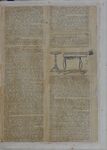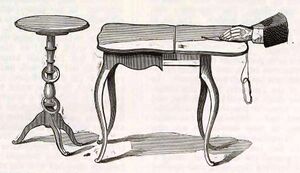HPB-SB-8-33: Difference between revisions
mNo edit summary |
mNo edit summary |
||
| (3 intermediate revisions by the same user not shown) | |||
| Line 41: | Line 41: | ||
| title = | | title = | ||
| subtitle = | | subtitle = | ||
| untitled = | | untitled = yes | ||
| notes = | | notes = | ||
| categories = engravings | | categories = engravings | ||
| Line 54: | Line 54: | ||
“From the foregoing it may be seen that my ''prepared ''experiments did not succeed in the manner ''expected ''by me. For example, the two wooden rings were not linked together, but instead were transferred from the sealed cat-gut to the leg of the round birchen table. The seal was not loosened, nor was the top of the table at any time removed; and it still remains tightly fastened.” | “From the foregoing it may be seen that my ''prepared ''experiments did not succeed in the manner ''expected ''by me. For example, the two wooden rings were not linked together, but instead were transferred from the sealed cat-gut to the leg of the round birchen table. The seal was not loosened, nor was the top of the table at any time removed; and it still remains tightly fastened.” | ||
{{Footnotes start}} | |||
<nowiki>*</nowiki> See ''The Spiritualist ''for February 15th, 1878, p. 78. | |||
† The annexed woodcut is an exact copy. | |||
{{Footnotes end}} | |||
{{Style S-HPB SB. Continues on|8-34}} | {{Style S-HPB SB. Continues on|8-34}} | ||
{{HPB-SB-footer-footnotes}} | {{HPB-SB-footer-footnotes}} | ||
Latest revision as of 06:40, 30 September 2025
 |
vol. title: Vol Four of The Theosophical Society of The Arya Samaj of Arya-wart vol. period: Sept 1878 – Sept 1879 pages in vol.: 350 |
< Professor Zollner's Experiments With Ddr. Slade (continued from page 8-32) >
were correct, such beings must be able to produce footmarks in a closed slate as well as on an open one. Slade said he thought it was impossible, but he consented to try, and even allowed Mr. Zollner to have the slate on his lap during the experiment, in order that he might keep it fully in view. After sitting about five minutes in a well-lighted room, all hands being on the table, Mr. Zollner remarked that he had twice felt a pressure on the slate in his lap, but that he had seen nothing. Three raps on the table announced that all was finished; on opening the slate, two impressions were found—one of a right, the other of a left foot—on the prepared paper on either side of the slate.
Professor Zollner says: “My readers may judge for themselves how far it is possible for me, after witnessing these facts, to consider Slade either an impostor or a conjuror. Slade’s own astonishment at this last result was even greater than my own. Whatever may be thought of the correctness of my theory with regard to the existence of intelligent beings in four-dimensional space, at all events it cannot be said to be useless as a clue to research in the mazes of Spiritualistic phenomena.”
Passing over the Professor’s strictures on the position of such men of science as Helmholtz and Virchow towards these phenomena, we will proceed to the experiments related in the third volume of the Abhandlungen, which took place during a subsequent visit of Slade to Leipzig, in May, 1878. We quote from the text:—
“The experiments formerly described (17th Dec.*) with the knotted cord suggests two explanations, according as one supposes a space of three or of four dimensions. In the first case, there must have been a so-called passage of matter through matter; or, in other words, the molecules of which the cord consists must have been separated in certain places, and then, after the other portion of cord had been passed through, again united in the same position as at first. In the second case, the manipulation of the flexible cord being, according to my theory, subject to the laws of a four-dimensional region of space, such a separation and re-union of molecules would not be necessary. The cord would, however, certainly undergo during the process an amount of twisting which would be discernible after the knots were tied. I had not paid attention to this circumstance in December last year, and had not examined the cords with regard to the size and direction of the twist. The following experiment, however, which took place on the 8th May this year, in a sitting of a quarter of an hour’s duration, with Mr. Slade in a well-lighted room, furnishes an answer to the above question in favour of the four-dimensional theory without separation of material particles.
The experiment was as follows:—“I took two bands cut out of soft leather, 44 centimetres long, and from 5 to 10 millimetres broad, and fastened the end of each together, as formerly described with the cords, and sealed them with my own seal. The two leather bands were laid separately on the card table at which we sat; the seats were placed opposite to one another, and I held my hands over the bands. Slade sat at my left side, and placed his right hand gently over mine, I being able to feel the leather underneath all the time. Slade asserted that he saw lights emanating from my hands, and could feel a cool wind over them. I felt the latter, but could not see the lights. Presently, while I still distinctly felt the cool breeze, and Slade’s hands were not touching mine, but were removed from them about two or three decimetres, I felt a movement of the leather bands under my hands. Then came three raps in the table, and on removing my hands the two leather bands were knotted together. The twisting of the leather is distinctly seen in the photographic illustration at the end of Vol. III. The time that the bands were under my hands was at most three minutes.”
Several instances are related of apports, or of objects being brought in an abnormal manner to those sitting with the medium. Pieces of wood and coal were observed to descend from the ceiling, and on one occasion a book was removed from its position on a slate held under the flap of the table, and about five minutes afterwards was seen to fall from the ceiling in a slanting direction on to the table.
The most striking case of this kind was that in which a small round table, which stood beyond that at which Slade and Zollner were sitting, one day moved gradually towards them, and laid itself sideways on the floor at their feet. It then vanished, and a few minutes later descended from the ceiling on to the larger table at which they sat. For a full account of this remarkable phenomenon, we refer our readers to the Wiss. Abh., Vol. III., p. 917, while we hasten to relate the last crowning event of Zollner’s experiences with Slade.
The Professor procured two wooden rings, one of oak, the other of alder, each turned in one entire piece. The outer diameter of the rings was 105 millimetres, the inner 74 millimetres. He further procured a long strip of bladder, cut in one entire piece without break or join, forming a kind of endless cord or band.
Professor Zollner says: “On the 9th May, at seven o’clock in the evening, I was alone with Slade in our usual sitting room. A fresh wind having blown all the afternoon, the sky was remarkably clear, and the room, which has a westerly aspect, was brilliantly lighted by the setting sun. The two wooden rings and the above-mentioned entire bladder band were strung on to a piece of catgut one millimetre in thickness, and 105 metre in length. The two ends of the cat-gut were tied together by myself in a knot, and then, as formerly in the case of the string, secured with my own seal.
“When Slade and I were seated at the table in the usual manner, I placed my two hands over the upper end of the sealed cat-gut, as shown in the plate, photographed from life.† The small round table, already referred to, was placed shortly after our entry into the room, in the position shown in the picture.
“After a few minutes had elapsed, and Slade had asserted,

as usual during physical manifestations, that he saw lights, a slight smell of burning was apparent in the room; it seemed to come from under the table, and somewhat recalled the smell of sulphuric acid. Shortly afterwards we heard a rattling sound, at the small round table opposite, as of pieces of wood knocking together. When I asked whether we should close the sitting, the rattling was repeated three times consecutively. We then left our seats, in order that we might ascertain the cause of the rattling at the round table. To our great astonishment we found the two wooden rings, which about six minutes previously were strung on the catgut, in complete preservation, encircling the leg of the small table. The catgut was tied in two loose knots, through which the endless bladder band was hanging uninjured.
“Immediately after the sitting .... Slade fell into one of his usual trances, and informed us that the invisible beings surrounding him had endeavoured, according to my wish, to tie some knots in the endless band, but had been obliged to abandon their intention, as the band was in danger of ‘melting’ during the operation under the great increase of temperature, and that we should perceive this by the whiteness of a spot on the band.
“Having taken the band into my own hands immediately after the sitting, and held it up to the moment of Slade’s communication, I felt great interest in testing the correctness of this assertion. There was, in fact, a white spot as indicated, and when we took another piece of exactly the same material and held it over a lighted candle, the effect of the increased temperature was to produce precisely such another white spot. This fact, in connection with the burning smell perceived during the sitting, as well as the increase in temperature in a former experiment (related on p. 925, Wiss. Abh.), will be worth bearing in mind in further experiments with four-dimensional movements of bodies. ...
“From the foregoing it may be seen that my prepared experiments did not succeed in the manner expected by me. For example, the two wooden rings were not linked together, but instead were transferred from the sealed cat-gut to the leg of the round birchen table. The seal was not loosened, nor was the top of the table at any time removed; and it still remains tightly fastened.”
* See The Spiritualist for February 15th, 1878, p. 78.
† The annexed woodcut is an exact copy.
<... continues on page 8-34 >
Editor's notes
- ↑ image by unknown author
